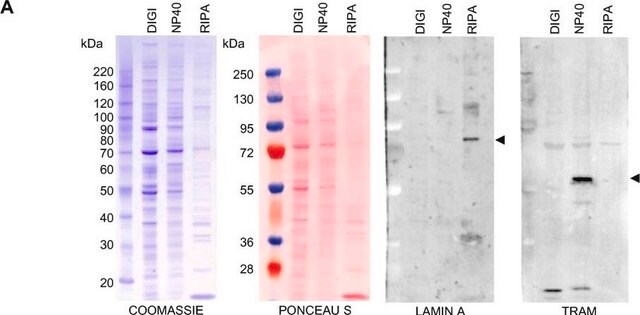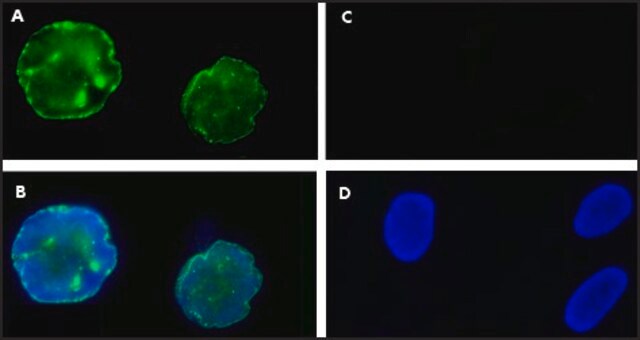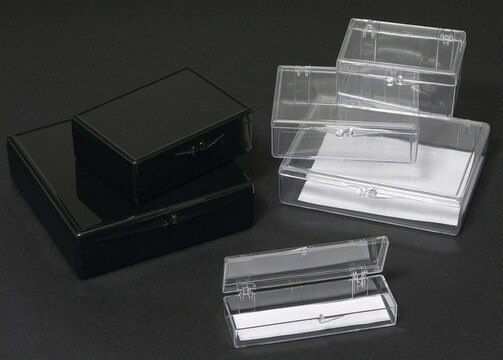MABT1341
Anti-Lamin A/C Antibody, clone 4C11
clone 4C11, from mouse
Sinónimos:
70 kDa Lamin, Renal carcinoma antigen NY-REN-32
About This Item
Productos recomendados
origen biológico
mouse
forma del anticuerpo
purified immunoglobulin
tipo de anticuerpo
primary antibodies
clon
4C11, monoclonal
reactividad de especies
human, monkey, Syrian hamster, rat, mouse
envase
antibody small pack of 25 μg
técnicas
ChIP: suitable
immunofluorescence: suitable
immunoprecipitation (IP): suitable
western blot: suitable
isotipo
IgG2aκ
Nº de acceso NCBI
Nº de acceso UniProt
modificación del objetivo postraduccional
unmodified
Información sobre el gen
human ... LMNA(4000)
Descripción general
Especificidad
Inmunógeno
Aplicación
Cell Structure
Dot Blot Analysis: A representative lot detected Lamin A/C in Dot Blot applications (Roblek, M., et. al. (2010). PLoS One. 5(5):e10604).
Immunocytochemistry Analysis: A 1:1,000 dilution from a representative lot detected Lamin A/C in HeLa cells.
Western Blotting Analysis: A representative lot detected Lamin A/C in WB used to demonstrate high titration and excellent properties of clone 4C11 (Courtesy of Marie lang, M.D., Stefan Schuchner, Ph.D. and Egon Ogris, M.D., Medical University of Vienna, Austria).
Immunofluorescence Analysis: A representative lot detected the Lamin A/C species at the nuclear lamina of HeLa cells (Courtesy of Marie Lang, M.D., Stefan Schuchner, Ph.D. and Egon Ogris, M.D., Medical University of Vienna, Austria).
Immunoprecipitation Analysis: A representative lot detected Lamin A/C in WB used to demonstrate high titration and excellent properties of clone 4C11 (Courtesy of Marie Lang, M.D., Stefan Schuchner, Ph.D. and Egon Ogris, M.D., Medical University of Vienna, Austria).
Chromatin Immunoprecipitation (ChIP) Analysis: A representative lot detected Lamin A/C in Chromatin Immunoprecipitation applications (Gesson, K., et. al. (2016). Genome Res. 26(4):462-73).
Immunofluorescence Analysis: A representative lot detected Lamin A/C in Immunofluorescence applications (Roblek, M., et. al. (2010). PLoS One. 5(5):e10604).
Immunoprecipitation Analysis: A representative lot immunoprecipitated Lamin A/C in Immunoprecipitation applications (Gesson, K., et. al. (2016). Genome Res. 26(4):462-73).
Calidad
Western Blotting Analysis: 0.2 µg/mL of this antibody detected Lamin A/C in HeLa cell lysate.
Descripción de destino
Forma física
Almacenamiento y estabilidad
Otras notas
Cláusula de descargo de responsabilidad
¿No encuentra el producto adecuado?
Pruebe nuestro Herramienta de selección de productos.
Código de clase de almacenamiento
12 - Non Combustible Liquids
Clase de riesgo para el agua (WGK)
WGK 1
Punto de inflamabilidad (°F)
Not applicable
Punto de inflamabilidad (°C)
Not applicable
Certificados de análisis (COA)
Busque Certificados de análisis (COA) introduciendo el número de lote del producto. Los números de lote se encuentran en la etiqueta del producto después de las palabras «Lot» o «Batch»
¿Ya tiene este producto?
Encuentre la documentación para los productos que ha comprado recientemente en la Biblioteca de documentos.
Nuestro equipo de científicos tiene experiencia en todas las áreas de investigación: Ciencias de la vida, Ciencia de los materiales, Síntesis química, Cromatografía, Analítica y muchas otras.
Póngase en contacto con el Servicio técnico








